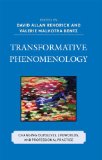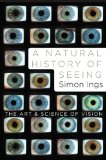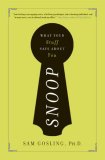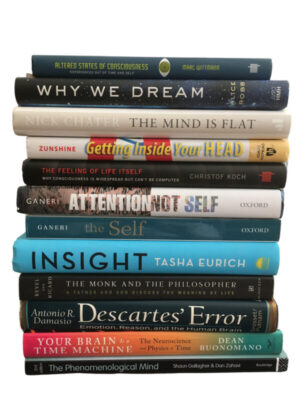
I recently read Transformative Phenomenology: Changing Ourselves, Lifeworlds, and Professional Practice, hoping to find some instructions for phenomenological techniques. The book is a collection of accounts by students at Fielding Graduate University.
Most of the articles were descriptions of the results of applying phenomenological techniques to various experiences, with only a few hints on what they were actually doing, although after reading through many accounts it was possible to get a rough idea of the method. The first step is to collect written accounts (“protocols”) of experience on a certain theme, either from one’s own experience or from a group of people who share the experience being investigated. These accounts are studied to discover common themes.
In the introduction, three specific phenomenological techniques are discussed: bracketing, imaginative variations, and horizontalization:
p. 11-17
bracketing – learn “to recognize, then set aside, the myriad assumptions, filters, conceptual frameworks that structure our perceptions and experiences.” levels – (1) suspend what has been learned from scientific studies, accepted theories, legitimated sources of knowledge (2) notions from cultural milieu; third deeper level, set aside object of consciousness itself, to experience pure consciousness, the self beneath the particular content.
imaginative variations – one imaginatively changes components with the aim of discovering what must be present, what does not need to be present for the phenomenon to exist
horizontalization – making elements in a situation equal and putting that situation at a distance to better view it without assumptions or bias
One article — Intentionality in Action by David B. Haddad — did spell out a method, since his project involved teaching the process to artists:
p. 196-197
My goal was to instruct artists with no prior knowledge of phenomenology to write and think about their work using the techniques of writing protocols, and work with them using bracketing, imaginative variations, and other phenomenological techniques…
!. Initiate an act of intentionality simply by making a spontaneous choice. Participants were urged to make their choice about a future state of affairs.
2. Describe your choice in the fullest possible detail. To assist the participants, I encouraged them to base their descriptions on a range of existential categories. I asked them to describe their intentional act in terms of time, space, the body, and their relationships to others. Meditation develops most of its content by applying these existential prompts.
3. Next was the clustering phase, to cluster meanings, to identify and isolate themes. Phrases, sentences, even whole paragraphs, of rich description were brought together into concentrations of like thoughts. Then we mined their horizontal qualities. Each horizon of the meditation was an aspect of the meaning within the overall meditation. Each was considered on its own merits, in isolation from the rest, so that its full significance could be felt and explored. Once exploration of horizons begins, one quickly discovers their open-endedness. Horizons of meaning possess inexhaustible qualities.
4. Next, we inverted the contents of the meditation. By subjecting the results gained to playfully upturned, imaginative reversals and polarities, we were able to shake ourselves out of any residual linear thinking and consider the radical breadth still buried in the original act of intentionality.
5. Finally, we reassessed and condensed the entire meditation into a final synthesis. Whereas all of the above steps were carried out in writing, only the final synthesis was open to artistic rather than textual rendering.









